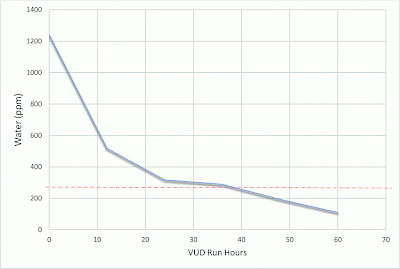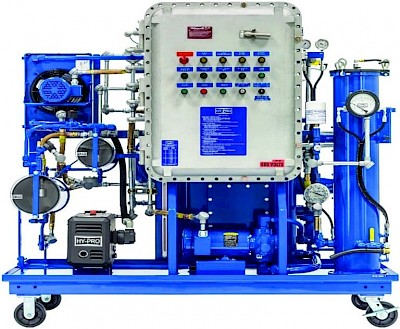Measuring the Effectiveness of Vacuum Dehydrators
Lubricant fluids are carefully formulated for specific areas of application and are comprised of base stock and an additive package. The additive package consists of chemical compounds designed to protect the base stock, as well as system components and to ensure proper performance of the system.
Water is considered one of the biggest enemies of rotating equipment and their lubrication systems. The presence of water in a lubrication system can result in many problems such as corrosion of equipment, depletion of additives and loss of oil lubricity. These problems could lead to accelerated wear of internal components and irreparable damage to the equipment. In addition, lube oil life can be significantly reduced when mixed with water even at low concentrations due to accelerated oxidation. Therefore, removal of water in lubrication fluids is extremely important as soon as identified via laboratory testing.
Water contamination can arise from several sources including leaks from inadequate sealing surfaces, condensation of humid air or from open reservoirs. In addition, a reduction in the temperature of the fluid can lead to the generation of free water from dissolved water. Each fluid type has a typical water saturation profile based on the base stock, additive package and presence of degradation by-products.
This article discusses the effectiveness of a vacuum dehydrator to remove water contamination from lubricating oils and if there are any degradation effects of the oil.
Forms of Water Contamination
Water can exist in oil systems in three distinct forms: Free, emulsified and dissolved water. Table 1 highlights the differences between these three forms.
| Form of Water | Free Water | Emulsified Water | Dissolved Water |
|---|---|---|---|
| Description | Water content well above fluid saturation point. Water exists in the form of a completely separate layer with the oil. | Water content above fluid saturation point. Water is emulsified with the oil, forming a cloudy mixture. | Water content below fluid saturation point. Water is solubilized in the oil, resulting in a clean and normal looking lubricant. |
| Impact | Severe Rusting Lube oil degradation | Rusting Clogged Filters Improper lubrication Lube oil degradation | Additive depletion Lube oil degradation |
| Method of Separation | Draining via gravity Centrifuge Coalescers Cellulose Media Vacuum Dehydrator | Offline Filtration (Centrifuge, Cellulose Media, Vacuum Dehydrator) | Offline Filtration (Vacuum Dehydrator) |

Vacuum Dehydrator
Vacuum dehydrators work by heating up the oil while simultaneously drawing a vacuum. When the oil-water mixture is exposed to a vacuum, the boiling point of water is reduced. This allows the water to flash via the heat into vapour, which is then recondensed, to be rejected from the system.
Because the boiling point of water is reduced, this allows the oil to be heated to a temperature low enough to stop the thermal breakdown of the oil and additives. Vacuum dehydrators also have the advantage of removing all forms of water, including dissolved water, which is not possible through other typical water removal purification systems, such as coalescers and centrifuges. Figure 1 displays the different components in a vacuum dehydrator.

Vacuum Dehydrator Experiment
Machine: Steam Turbine Vacuum
Dehydrator run: 60 Hours
Start Date: February 29
End Date: March 3
Sump Size: 1500 litres
Capacity of Vacuum Dehydrator: V10
Set Oil Temperature: 50oC
The subject machine was found with high water content (1250 ppm) in the lube oil system through the condition monitoring program. The root cause was attributed to leaking seals. Hence, it was decided to utilize this equipment for the trial. The turbine was kept shutting down during the experiment to stop further water ingression through leaky seals and properly understand the effectiveness of the vacuum dehydrator.
For this trial, a portable vacuum dehydrator was used. It was connected to the lube oil reservoir as a kidney loop filtration system. The temperature was set at 50oC during purification. The purification process was continued for 60 hours and water content and AN were measured for oil samples collected every 12 hours during purification. The rotating pressure vessel oxidation test (RPVOT) was also measured for new and used oil before and after purification.

The results are captured below:
• Water (ppm): Water content was reduced from 1250 ppm to 250 ppm within 25 hours of operation and it took 35 additional hours to further reduce the water content from 250 ppm to 100ppm. The saturation point of the used turbine oil was around 250 ppm and is highlighted in the graph with a dashed line. Therefore, free water and emulsified water can be removed rapidly from the lube oil by the vacuum dehydrator. It is time-consuming to remove dissolved water from the lube oil.

• AN (Acid Number): There was no significant impact on the AN of the turbine oil from running the vacuum dehydrator. It fluctuated from 0.07 to 0.08 mg KOH/gm from the start to the end of the purification process.
• RPVOT: The new oil had a higher RPVOT value than the used oil as usual. There was no significant change of RPVOT for the turbine oil at the beginning and end of the purification process by the vacuum dehydrator.
An experimental trial was conducted on a Saudi Aramco gas turbine that had unacceptable levels of water contamination in its lube oil.
The purpose of the trial was to test the effectiveness of water removal from lube oil using vacuum dehydration.

Looking at the results, the vacuum dehydrator was effective in removing all forms of water contamination from the lube oil. Within 60 hours of operation, it was possible to reduce the water content from 1250 ppm to 100 ppm, which is way below the 250 ppm saturation point of the turbine oil used in this gas turbine.
The water removal rate is relatively slow once the concentration drops below saturation point and therefore it is economical to stop the vacuum dehydrator after achieving water contamination below the saturation point. The vacuum dehydrator does not degrade lube oil during the purification process and there was no significant impact noticed on the AN and RPVOT of the oil.
